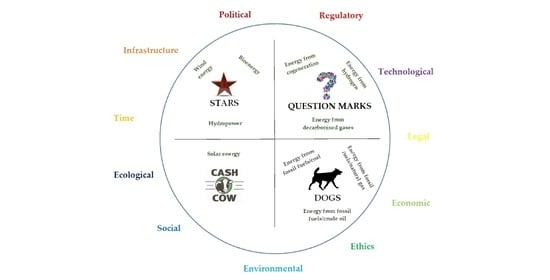Energy Portfolio of the Eastern Poland Macroregion in the European Union
Abstract
:1. Introduction
- The identification of conditions and premises for transformation of the energy portfolio of the Eastern Poland macroregion, and of its individual parts—provinces;
- A forecast of the courses of evolution of the energy portfolio of the Eastern Poland macroregion triggered by the necessity to implement the Green Deal of the European Union by 2030;
- Recommendations for the energy transformation of the Eastern Poland macroregion.
2. Theoretical Approach
- The availability of energy sources (renewable and non-renewable, wind, solar, water including geothermal, biomass and biogas/ bioenergy, decarbonised gas energy—biomethane, LNG, CNG, cogeneration, hydrogen and fossil fuels, coal, gas and oil);
- The expected life cycle of the energy production technology used and the phase it is currently in (it was assumed that this depends on the development possibilities of the technology, the degree of standardisation, the universality of solutions, and the legal and financial conditions resulting from the implementation of the European Green Deal) [37,38,39];
- The financial resources required and the efficiency of their use over time.
- D—a baseline source, i.e., a still widely used source with diminishing impact due to declining usage. In the BCG matrix they are situated in the dogs field (also called: ball, ballasts, lame ducks);
- CC—key source, which is the primary source of energy supply for the region and is at a mature stage and not requiring large investments. In the BCG matrix, they are located in the cash cow field (also called: golden hens);
- S—a key source which forms the core of the region’s energy supply, but which is still in the development phase and thus requires considerable financial investment. In the BCG matrix, they are positioned in the field of stars (or hits);
- QM—experimental source—which is in its infancy, with high financial needs and poor results, but indicating that it will become a key source for the region in the future. In the BCG matrix, they are positioned in the field of question marks (or problems, difficult children, wildcats).
- A balanced portfolio including sources categorised as ‘cash cow’ and ‘mature stars’. These represent the main source of energy supply and will continue to be developed to ensure the continuity of entities operating in the region. Furthermore, conditions are being created for the development of new energy sources in the region;
- An insufficient portfolio, which could take the form of a declining portfolio or a fledgling portfolio. A declining portfolio can provide business continuity for entities operating in the region, but is undevelopable and, in the long term, could threaten the region’s energy security. Conversely, the fledgling portfolio is developable but is unsustainable and thus could lead to liquidity crises.
- Political, including aspects of the political, legal, regulatory, and of time;
- Economic, evaluating aspects of the economic, environmental, and ecological;
- Social issues, in terms of problems: social, ethics;
- Technological, analysing technological development, infrastructure.
- PESTLE (political, economic, socio-cultural, technological, legal and environmental) [48];
- PMESII-PT (political, military, economic, social, information, infrastructure, physical environment, time—used in military terms);
- STEEPLE (social, technological, environmental, economic, political, legal, ethical) [49];
- STEEPVL (social, technological, economical, ecological, political, values and legal) [50] (p.110);
- PRESTCOM (in addition to political, regulatory, economic, social, technological factors, it also includes competitive, organisational and market factors) [51] (p. 120).
- Records of strategic documents (e.g., regional development strategies) of the analysed voivodships/regions of the Eastern Poland macroregion, which are announcements of undertaken initiatives;
- Subject literature reflecting investment trends in the region;
- The results of surveys conducted among a carefully selected group of decision-makers: five provincial governors as the administrative authorities on the ground (the marshal is the chair of the provincial assembly, the executive body of the regional government) and three representatives of the municipal associations.
- Eight single-response questions (single response and multi-alternative);
- Six questions requiring the selection of several answers (multi-alternative);
- Six questions needing to establish a ranking and probabilities;
- Fifteen questions requiring an evaluation of the categories included in them in terms of trends and the likelihood of specified phenomena occurring. Their use enabled us to determine the development prospects of the energy portfolio in 2030.
3. Results
3.1. Determinants and Prerequisites of Energy Portfolio Transformation in the Eastern Poland Macroregion—Questionnaire Results
- The occurrence of particularly unfavourable macroeconomic changes (e.g., an increase in inflation, an increase in lending interest rates, increased unemployment, lowering of the economic growth rate) which will impede the development of green energy, with the greatest likelihood of a negative upward trend;
- A positive upward trend of the structural factor and the state of the economy influencing the development of the energy system, but there were fears of a downturn despite the low probability of this happening;
- Providing financial support for the development of renewable energy sources (Figure 3). Among the investment directions for which financial support was declared were investments in: solar energy, biomass and biogas energy, wind energy, followed by hydrogen, cogeneration and hydropower; the least mentioned was energy from decarbonised gases. It should be noted that these lines of investment are almost identical to those currently being pursued, namely in solar energy, wind energy, biomass and biogas energy, and energy from cogeneration, hydrogen and water, and least often from decarbonised gases;
- The emergence of an upward trend with a potentially positive impact on government support (financial, organisational, legal) for energy development in the region. However, the range of opinions in this area indicates the volatility of this factor, which should be seen as a threat to the development of the energy system. It is worth noting that the surveyed representatives indicated the need to prioritise financial, legal, and organisational support for transforming the energy portfolio;
- That there will, in all probability, be an upward trend with a potentially positive impact in the availability and use of renewable energy sources;
- A high level of commitment in the area of public consultations on planned energy policy changes (Figure 4), a high acceptance of activities aimed at disseminating information on energy policy changes (Figure 5), and low or medium acceptance by residents for the creation of RES installations near their place of residence (Figure 6);
- Most likely a downward trend with a potentially positive impact on environmental pollution from non-renewable energy sources, which in turn will positively influence the direction of energy policy in the region. However, the spread of opinion in this regard was considerable, indicating the high degree of uncertainty for this factor;
- A tightening of the requirements to meet environmental standards and norms, including ISO, with the potential for negative impacts resulting in a slowing down of the momentum of energy policy changes in the region;
- In the area of infrastructure, the development of greater energy independence for the region, based on the existing but upgraded model of the energy network (Figure 7);
- An upward trend with a positive impact on the formation of groups—cooperatives, including energy clusters—fostering the development of distributed energy in the region.
3.2. Potential Energy Portfolio for the Eastern Poland MacroRegion—Results of Institutional and Legal Analysis
- Low-carbon energy, including conventional energy based on coal and gas (including shale gas), as well as unconventional energy—energy from biomass, solar, wind and water;
- The bioeconomy, which involves the production of energy crops and the extraction and use of energy from renewable sources (biorefineries, biofuels). The reserves of agricultural land that can potentially be used to grow annual energy crops have been estimated at around 280,000 ha in the province [69].
3.3. Potential Energy Portfolio of Eastern Poland Macroregion—Questionnaire Results
3.4. Potential Energy Portfolio of Eastern Poland Macroregion—Change of Forecast
4. Discussion
5. Conclusions
- Stimulate economic activity, competitiveness and innovation in the regional economy, shape spatial management and preserve the value of the cultural and natural environment;
- Increase commitment and investment in raising public awareness and competence in the regions in the area of distributed, prosumer energy;
- Develop detailed analyses, feasibility studies, programmes for individual regions/provinces of the Eastern Poland macroregion scoping the anticipated energy transformation, taking into account the following issues: political/legal, economic/economic, social, geographical/environmental, and infrastructural/technological.
Author Contributions
Funding
Institutional Review Board Statement
Informed Consent Statement
Data Availability Statement
Conflicts of Interest
References
- A Clean Planet for All a European Strategic Long-Term Vision for a Prosperous, Modern, Competitive and Climate Neutral Economy, Communication from the Commission to the European Parliament, the European Council, the Council, the European Economic and Social Committee, the Committee of the Regions and the European Investment Bank, Brussels. Available online: https://eur-lex.europa.eu/legal-content/EN/TXT/PDF/?uri=CELEX:52018DC0773&from=en (accessed on 1 July 2021).
- Long-Term EU Budget 2021–2027 and Recovery Package, European Council. Available online: https://www.consilium.europa.eu/en/policies/the-eu-budget/long-term-eu-budget-2021-2027/ (accessed on 1 January 2021).
- Communication from the Commission to the European Parliament, the European Council, the Council, the European Economic and Social Committee and the Committee of the Regions. In The European Green Deal; European Commission: Brussels, Belgium; Available online: https://eur-lex.europa.eu/legal-content/PL/TXT/DOC/?uri=CELEX:52019DC0640&from=EN (accessed on 1 January 2021).
- Zhelyazkova, A.; Bølstad, J.; Meijers, M.J. Understanding responsiveness in European Union politics: Introducing the debate. J. Eur. Public Policy 2019, 26, 1715–1723. [Google Scholar] [CrossRef] [Green Version]
- Turnhout, E.; Behagel, J.; Ferranti, F.; Beunen, R. The construction of legitimacy in European nature policy: Expertise and participation in the service of cost-effectiveness. Environ. Politics 2015, 24, 461–480. [Google Scholar] [CrossRef]
- Steen, M.; Faller, F.; Ullern, E.F. Fostering renewable energy with smart specialisation? Insights into European innovation policy. Nor. J. Geogr. 2019, 73, 39–52. [Google Scholar] [CrossRef]
- Jänicke, M.; Wurzel, R.K.W. Leadership and lesson-drawing in the European Union’s multilevel climate governance system. Environ. Politics 2019, 28, 22–42. [Google Scholar] [CrossRef]
- Eckert, E.; Kovalevska, O. Sustainability in the European Union: Analyzing the Discourse of the European Green Deal. J. Risk Financ. Manag. 2021, 14, 80. [Google Scholar] [CrossRef]
- Johnston, A.; Regan, A. Introduction: Is the European Union Capable of Integrating Diverse Models of Capitalism? New Political Econ. 2018, 23, 145–159. [Google Scholar] [CrossRef] [Green Version]
- Gawlik, L. Energy transition in Poland. In Energy Policy Transition—The Perspective of Different States; Ruszel, M., Młynarski, T., Szurlej, A., Eds.; Ignacy Lukasiewicz Energy Policy Institute: Rzeszów, Poland, 2017; pp. 171–182. [Google Scholar]
- Gryz, J.; Kaczmarczyk, B. Toward Low-Carbon European Union Society: Young Poles’ Perception of Climate Neutrality. Energies 2021, 14, 5107. [Google Scholar] [CrossRef]
- Braun, J. State aid for environmental protection and energy objectives in Poland and other countries of the European Union. Optimum. Econ. Stud. 2020, 102, 69–78. [Google Scholar] [CrossRef]
- Melnikas, B. Creation of knowledge—based economy in the European Union: The main typicalities and new ideas of clusterization. J. Bus. Econ. Manag. 2005, 6, 87–100. [Google Scholar] [CrossRef] [Green Version]
- Geden, O.; Peters, G.P.; Scott, V. Targeting carbon dioxide removal in the European Union. Clim. Policy 2019, 19, 487–494. [Google Scholar] [CrossRef]
- “European Green Deal”—New European Development Vision. Available online: https://raport.togetair.eu/human/people-the-world-the-climate/european-green-deal-new-european-development-vision (accessed on 1 May 2021).
- Lachapelle, E.; MacNeil, R.; Paterson, M. The political economy of decarbonisation: From green energy ‘race’ to green ‘division of labour’. New Political Econ. 2017, 22, 311–327. [Google Scholar] [CrossRef]
- Ruszel, M.; Młynarski, T.; Szurlej, A. The concept of energy transition. In Energy Policy Transition—The Perspective of Different States; Ruszel, M., Młynarski, T., Szurlej, A., Eds.; Ignacy Lukasiewicz Energy Policy Institute: Rzeszów, Poland, 2017; pp. 28–37. [Google Scholar]
- Eastern Poland Programme, Programme Objectives. Available online: https://www.polskawschodnia.gov.pl/strony/o-programie/fe-dla-polski-wschodniej-2021-2027/zalozenia-nowego-programu (accessed on 1 January 2021).
- Energy from Renewable Sources in 2019; Central Statistical Office: Warsaw, Poland, 2020; pp. 13–19. Available online: https://stat.gov.pl/en/topics/environment-energy/energy/energy-from-renewable-sources-in-2019,3,12.html?pdf=1 (accessed on 1 May 2021).
- Renewable Energy Sources, Green Zones. Available online: https://zielonestrefy.pl/zielone-strefy/odnawialne-zrodla-energii/ (accessed on 1 June 2021).
- Program Operacyjny Polska Wschodnia 2014–2020 (Operational Programme Eastern Poland 2014–2020) (POPW). Available online: https://www.polskawschodnia.gov.pl/media/94092/POPW_8092020.pdf (accessed on 20 September 2021).
- Available online: swaid.stat.gov.pl/AtlasRegionow/AtlasRegionowMapa.aspx (accessed on 8 May 2021).
- Polska Wschodnia: Biała plama Energetyczna czy Nie?—Energetyka. Available online: https://www.wnp.pl/energetyka/polska-wschodnia-biala-plama-energetyczna-czy-nie,234296.html (accessed on 1 January 2021).
- Operational Programme Eastern Poland about the Programme. Available online: https://www.polskawschodnia.gov.pl/strony/o-programie/zasady/fe-2007-2013 (accessed on 1 January 2021).
- Siemiątkowski, P.; Tomaszewski, P.; Marszałek-Kawa, J.; Gierszewski, J. The Financing of Renewable Energy Sources and the Level of Sustainable Development of Poland’s Provinces in the Area of Environmental Order. Energies 2020, 13, 5591. [Google Scholar] [CrossRef]
- Zhou, W.; Zhu, W.; Chen, Y.; Chen, J. Dynamic changes and multi-dimensional evolution of portfolio optimization. Econ. Res. 2021, 34, 1–26. [Google Scholar] [CrossRef]
- Dohleman, B.S. Exploratory social network analysis with Pajek. Psychometrika 2006, 71, 605–606. [Google Scholar] [CrossRef]
- Hanif, W.; Hernandez, J.A.; Shahzad, J.; Hoang, T.H.-V.; Yoon, S.-M. Regional and copula estimation effects on EU and US energy equity portfolios. Appl. Econ. 2020, 52, 5311–5342. [Google Scholar] [CrossRef]
- Ahmad, W.; Rais, S. Time-Varying Spillover and the Portfolio Diversification Implications of Clean Energy Equity with Commodities and Financial Assets. Emerg. Mark. Financ. Trade 2018, 54, 1837–1855. [Google Scholar] [CrossRef]
- Owusu, P.A.; Asumadu-Sarkodie, S. A review of renewable energy sources, sustainability issues and climate change mitigation. Cogent Eng. 2016, 3, 1167990. [Google Scholar] [CrossRef]
- Fang, M.; Tan, K.S.; Wirjanto, T.S. Sustainable portfolio management under climate change. J. Sustain. Financ. Investig. 2019, 9, 45–67. [Google Scholar] [CrossRef]
- Brown, E.; Campbell, B.; Cloke, J.; To, L.S.; Turner, B.; Wray, A. Low carbon energy and international development: From research impact to policymaking. Contemp. Soc. Sci. 2018, 13, 112–127. [Google Scholar] [CrossRef] [Green Version]
- Bourgeois, L.J.; Duhaime, I.M.; Stimpert, J.L. Strategic Management Concise: A managerial Perspective; Horcourt College Publishers: Fort Worth, TX, USA, 2001; p. 238. [Google Scholar]
- Lynch, R. Corporate Strategy; Prentice Hall: Harlow, UK, 2000; pp. 176–177. [Google Scholar]
- Segev, E. Business Unit Strategy; John Wiley & Sons: Chichester, UK, 2000; pp. 155–156. [Google Scholar]
- Henderson, B. The Product Portfolio, The Boston Consulting Group. 1 January 1970. Available online: https://www.bcg.com/publications/1970/strategy-the-product-portfolio (accessed on 1 May 2021).
- Mascaraenhas, B.; Aaker, D.A. Strategy over the Business Cycle. Strateg. Manag. J. 1989, 10, 199–210. [Google Scholar] [CrossRef]
- Chatterjee, S. From Cycles to Shocks: Progress in Business Cycle Theory. Business Review 3, March/April 2000. pp. 1–10. Available online: https://fraser.stlouisfed.org/title/business-review-federal-reserve-bank-philadelphia-5580/march-april-2000-557711/cycles-shocks-522287 (accessed on 1 January 2021).
- Bayus, B. An Analysis of Product Lifetimes in a Technologically Dynamic Industry. Manag. Sci. 1998, 44, 763–775. [Google Scholar] [CrossRef] [Green Version]
- Power and Utilities. Available online: https://www.bcg.com/industries/energy/power-utilities/overview (accessed on 21 November 2021).
- Benchmark Your Building Using ENERGY STAR® Portfolio Manager®, Benchmark Your Building Using ENERGY STAR® Portfolio Manager®. Available online: www.energystar.gov/buildings/benchmark (accessed on 1 October 2021).
- Pyka, I.; Nocoń, A. Responsible Lending Policy of Green Investments in the Energy Sector in Poland. Energies 2021, 14, 7298. [Google Scholar] [CrossRef]
- Ahmed, M.M.; Shimada, K. The Effect of Renewable Energy Consumption on Sustainable Economic Development: Evidence from Emerging and Developing Economies. Energies 2019, 12, 2954. [Google Scholar] [CrossRef] [Green Version]
- Brodny, J.; Tutak, M.; Saki, S.A. Forecasting the Structure of Energy Production from Renewable Energy Sources and Biofuels in Poland. Energies 2020, 13, 2539. [Google Scholar] [CrossRef]
- Johnson, G.; Scholes, K. Exploring Corporate Strategy; Prentice Hall Europe: London, UK, 1999; p. 104. [Google Scholar]
- Bowman, C. Strategy in Pracice; Prentice Hall: Harlow, UK, 1998; pp. 89–90. [Google Scholar]
- Bradfield, R.; Wright, G.; Burt, G.; Cairmst, G.; van der Heijden, K. The origins and evolution of scenario techniques in long range business planning. Futures 2005, 37, 795–812. [Google Scholar] [CrossRef]
- Tapera, J. The Importance of Strategic Management to Business Organizations. Int. J. Res. J. Soc. Sci. Manag. 2014, 3, 126. Available online: https://www.researchgate.net/publication/301801352_The_Importance_of_Strategic_Management_to_Business_Organizations (accessed on 16 May 2021).
- Walden, J. Comparison of the STEEPLE Strategy Methodology and the Department of Defense’s PMESII-PT Methodology; Supply Chain Leadership Institute. 2011. Available online: http://www.supplychainresearch.com/images/Walden_Strategy_Paper.pdf (accessed on 10 May 2021).
- Knoniuk, A. Analiza STEEPVL na przykładzie projektu Foresight technologiczny. “NT FOR Podlaskie 2020” regionalna strategia rozwoju nanotechnologii. Econ. Manag. 2010, 4, 110. [Google Scholar]
- Pickton, D.; Broderick, A. Integrated Marketing Communications; Pearson Education: Harlow, UK, 2001; p. 120. [Google Scholar]
- Energis (A) PESTEL/PEST/STEP Analysis & Solution/MBA Resources, MBA PESTEL: Energis (A) Pestel/Analiza. Available online: https://embapro.com/frontpage/pestelcase/15889-energis-altnets (accessed on 1 January 2021).
- Narayanan, V.; Fahey, L. Macroenvironmental Analysis: Understanding the Environment Outside the Industry. In The Portable MBA in Strategy; Fahey, L., Randall, R., Eds.; John Wiley & Sons: New York, NY, USA, 2001; pp. 189–200. [Google Scholar]
- Portfel Energetyczny Wybranych Regionów Unii Europejskiej. Available online: https://forms.office.com/r/ty3gN7rLtJ (accessed on 1 January 2021).
- Europejski Zielony Ład, COM(2019) 640 Final, Komisja Europejska, Bruksela, Belgia. 2019. Available online: https://ec.europa.eu/transparency/documents-register/detail?ref=COM(2019)640 (accessed on 4 May 2021).
- Wettengel, J. Covering the EU’s “Fit for 55” Package of Climate and Energy Laws, Journalism for the Energy Transtion, 14 July 2021, Covering the EU’s “Fit for 55” Package of Climate and Energy Laws|Clean Energy Wire. Available online: https://www.edf.org/media/fit-55-turns-eus-climate-target-action-challenging-other-major-economies-follow (accessed on 21 August 2021).
- Polska w Zielonym Ładzie,—Korzyści, Możliwości i Ocena SWOT, Opinie i Ekspertyzy OE–307. Available online: https://www.senat.gov.pl/gfx/senat/pl/senatekspertyzy/5619/plik/oe_307.pdf (accessed on 21 August 2021).
- Krajowy Plan Odbudowy i Zwiększania Odporności; Ministerstwo Funduszy i Polityki Regionalnej: Warszawa. 2021. Available online: https://www.gov.pl/web/planodbudowy/czym-jest-kpo2 (accessed on 4 May 2021).
- Notice of the Minister of Climate and Environment of 2 March 2021; Polish Official Gazette: Warsaw, Poland, 2021.
- Warmińsko-Mazurskie 2030. Strategia Rozwoju Społeczno-Gospodarczego; Olsztyn. 2020. Available online: https://strategia.warmia.mazury.pl/strategia-2030/ (accessed on 15 May 2021).
- Strategia Rozwoju Społeczno–Gospodarczego Województwa Warmińsko—Mazurskiego do Roku 2020; Zarząd Województwa: Olsztyn, Poland, 2005; Available online: https://strategia.warmia.mazury.pl/poprzednie-strategie/ (accessed on 15 May 2021).
- Kontrakt Terytorialny dla Województwa Warmińsko-Mazurskiego; Zarząd Województwa Warmińsko-mazurskiego: Olsztyn, Poland. 2014. Available online: https://docplayer.pl/112540422-Kontrakt-terytorialny-dla-wojewodztwa-warminsko-mazurskiego.html (accessed on 1 June 2021).
- Strategia Rozwoju Województwa Podlaskiego do Roku 2020; Urząd Marszałkowski Województwa Podlaskiego. 2013. Available online: https://strategia.wrotapodlasia.pl/pl/ps2/var/resources/154/248/4/srwp_2020_1.pdf (accessed on 1 June 2021).
- Strategia Rozwoju Województwa Podlaskiego 2030; Departament Rozwoju Regionalnego UMWP: Białystok, Poland. 2020. Available online: https://strategia.wrotapodlasia.pl/pl/strategia_rozwoju_wojewdztwa_podlaskiego_2030/ (accessed on 1 June 2021).
- Kontrakt Terytorialny dla Województwa Podlaskiego; Serwis Regionalnego Programu Województwa Podlaskiego. 2014. Available online: https://rpo.wrotapodlasia.pl/pl/dowiedz_sie_wiecej_o_programie/zapoznaj_sie_z_prawem_i_dokument/kontrakt-terytorialny-dla-wojewodztwa-podlaskiego.html (accessed on 1 June 2021).
- Lubelskie Province Development Strategy 2014–2020; Lubelskie Provincial Marshal’s Administration: Lublin, Poland, 2014; Available online: https://lublin.eu/gfx/lublin/userfiles/_public/pliki_do_pobrania/strategia_rozwoju_lublina_na_lat/lublin_development_strategy_2013-2020.pdf (accessed on 1 June 2021).
- Strategia Rozwoju Województwa Lubelskiego do 2030 Roku; Zarząd Województwa Lubelskiego: Lublin, Poland, 2021; Available online: https://strategia.lubelskie.pl/srwl/srwl.2021.04.02.pdf (accessed on 29 May 2021).
- Kusińska, E. Contemporary Cities of the Ruhr—Green Post-Industrial Agglomerations. Hous. Environ. 2018, 24, 179–185. Available online: https://repozytorium.biblos.pk.edu.pl/resources/41455 (accessed on 1 June 2021).
- Regionalna Strategia Innowacji Województwa Lubelskiego do 2020 Roku; Lublin, Poland. 2014. Available online: https://www.researchgate.net/publication/308379380_Regionalna_Strategia_Innowacji_Wojewodztwa_Lubelskiego_do_roku_2020 (accessed on 1 June 2021).
- Strategia Rozwoju Województwa Świętokrzyskiego do 2020 Roku; Uchwała Nr XXXIII/589/13 Sejmiku Województwa Świętokrzyskiego z Dnia 16 Lipca 2013 r. Available online: https://www.swietokrzyskie.pro/file/2019/07/Strategia-Rozwoju-Wojew%C3%B3dztwa-%C5%9Awi%C4%99tokrzyskiego-do-roku-2020.pdf (accessed on 1 June 2021).
- Kwaśniewski, D. Efektywność energetyczna produkcji biomasy z trzyletniej wierzby. Inżynieria Rol. 2010, 5, 113–119. [Google Scholar]
- Świętokrzyskie Centrum Innowacji i Transferu Technologii. Available online: https://it.kielce.pl/ (accessed on 29 May 2021).
- Strategia Rozwoju Województwa Świętokrzyskiego 2030+; Załącznik do Uchwały nr XXX/406/21 Sejmiku Województwa Świętokrzyskiego, z Dnia 29 Marca 2021, Kielce. 2021. Available online: https://www.swietokrzyskie.pro/category/wojewodztwo-swietokrzyskie/strategia-rozwoju-wojewodztwa-swietokrzyskiego-2030 (accessed on 29 May 2021).
- Pacocha, A.K. Perspektywy Rozwoju Odnawialnych Źródeł Energii w Świętokrzyskiem; Departament Rozwoju Obszarów Wiejskich Urzędu Marszałkowskiego. 2012. Available online: https://www.swietokrzyskie.pro/perspektywy-rozwoju-odnawialnych-zrodel-energii-w-swietokrzyskiem/ (accessed on 10 May 2021).
- Uszczegółowienie Inteligentnych Specjalizacji Województwa Świętokrzyskiego. Załącznik 1. do Planu Wykonawczego do RIS3. 2015. Available online: http://www.2014-2020.rpo-swietokrzyskie.pl/dowiedz-sie-wiecej-o-programie/zapoznaj-sie-z-prawem-i-dokumentami/dokumenty-regionalne/item/210-regionalne-inteligentne-specjalizacje-wojewodztwa-swietokrzyskiego (accessed on 30 May 2021).
- Strategia Rozwoju Województwa—Podkarpackie 2030; Rzeszów, Poland. 2020. Available online: https://www.podkarpackie.pl/index.php/strategia/7812-strategia-rozwoju-wojewodztwa-podkarpackie-2030-przyjeta-przez-sejmik-wojewodztwa-podkarpackiego (accessed on 30 May 2021).
- Kwinta, W. Więcej Gazu Ziemnego w Starym Złożu. 2020. Available online: https://inzynieria.com/paliwa/wiadomosci/59167,podkarpacie-odkryto-nowe-zloze-gazu-ziemnego (accessed on 29 May 2021).
- Wojewódzki Program Rozwoju Odnawialnych Źródeł Energii dla Województwa Podkarpackiego. 2013. Available online: https://bip.podkarpackie.pl/attachments/article/1020/874_1.pdf (accessed on 15 June 2021).
- Projekt Polskiej Strategii Wodorowej do 2030 r. Available online: http://www.airproducts.com.pl/ (accessed on 12 June 2021).
- Biznes. Inteligentne Specjalizacje Województwa Podkarpackiego. Available online: https://podkarpackie.eu/biznes/inteligentne-specjalizacje-wojewodztwa-podkarpackiego/ (accessed on 15 June 2021).
- Kontrakt Terytorialny dla Województwa Podkarpackiego; Zarząd Województwa Podkarpackiego: Rzeszów, Poland, 2014; Available online: https://www.podkarpackie.pl/index.php/rozwoj-regionalny/kontrakt-terytorialny/5194-kontrakt-terytorialny-podstawowe-dokumenty (accessed on 10 June 2021).
- Na Podkarpaciu Będzie Produkowany Zielony Wodór. Powstanie Dolina Wodorowa. GLOBEnergia. Available online: https://globenergia.pl/podkarpacka-dolina-wodorowa-zielony-wodor-oze-energetyka/ (accessed on 19 May 2021).
- Krajowa Strategia Rozwoju Regionalnego 2030. Rozwój Społecznie Wrażliwy i Terytorialnie Zrównoważony; Warszawa, Poland. 2019, p. 27. Available online: http://ekonomiaspoleczna.lubelskie.pl/images/artykuly/2019/strategia_rozwoju/krajowa_strategia_rozwoju_regionalnego_2030.pdf (accessed on 10 June 2021).
- Energia ze Źródeł Odnawialnych w 2019 r; Główny Urząd Statystyczny: Warszawa, Poland, 2020. Available online: https://stat.gov.pl/obszary-tematyczne/srodowisko-energia/energia/energia-ze-zrodel-odnawialnych-w-2019-roku,10,3.html (accessed on 25 September 2021).
- Europe’s Energy Transition, Renewables Overtook Fossil Fuels in European Energy Generation Last Year for the First Time. Geopolitical Futures, 29 January 2021, Europe’s Energy Transition|Geopolitical Futures, 29 January 2021. Available online: https://geopoliticalfutures.com/europes-energy-transition/ (accessed on 21 August 2021).
- Oozeki, T.; Izawa, T.; Otani, K.; Kurokawa, K. An evaluation method of PV systems. Sol. Energy Mater. Sol. Cells 2003, 75, 687–695. [Google Scholar] [CrossRef]
- Fodrowska, K. Elektrownie Wodne w Polsce (Hydroelectric Power Plants in Poland), Enerad.pl. Available online: https://enerad.pl/aktualnosci/elektrownie-wodne-w-polsce/ (accessed on 22 August 2021).
- Hydroelektrownie Szkodzą Środowisku i Naszym Finansom (Hydroelectric Power Plants Harm the Environment and Our Finances). WWF Polska. Available online: https://www.wwf.pl/aktualnosci/hydroelektrownie-szkodza-srodowisku-i-naszym-finansom (accessed on 22 August 2021).
- Drogi a Środowisko, Stowarzyszenie Integracji Stołecznej Komunikacji. Available online: http://www.siskom.waw.pl/nauka/srodowisko/natura2000-sip-konflikty.PNG/ (accessed on 20 August 2021).
- Regional Directorate of State Forests in Zielona Góra. Available online: https://www.zielonagora.lasy.gov.pl/obszary-natura-2000#.YSOIg44zaUk (accessed on 23 August 2021).


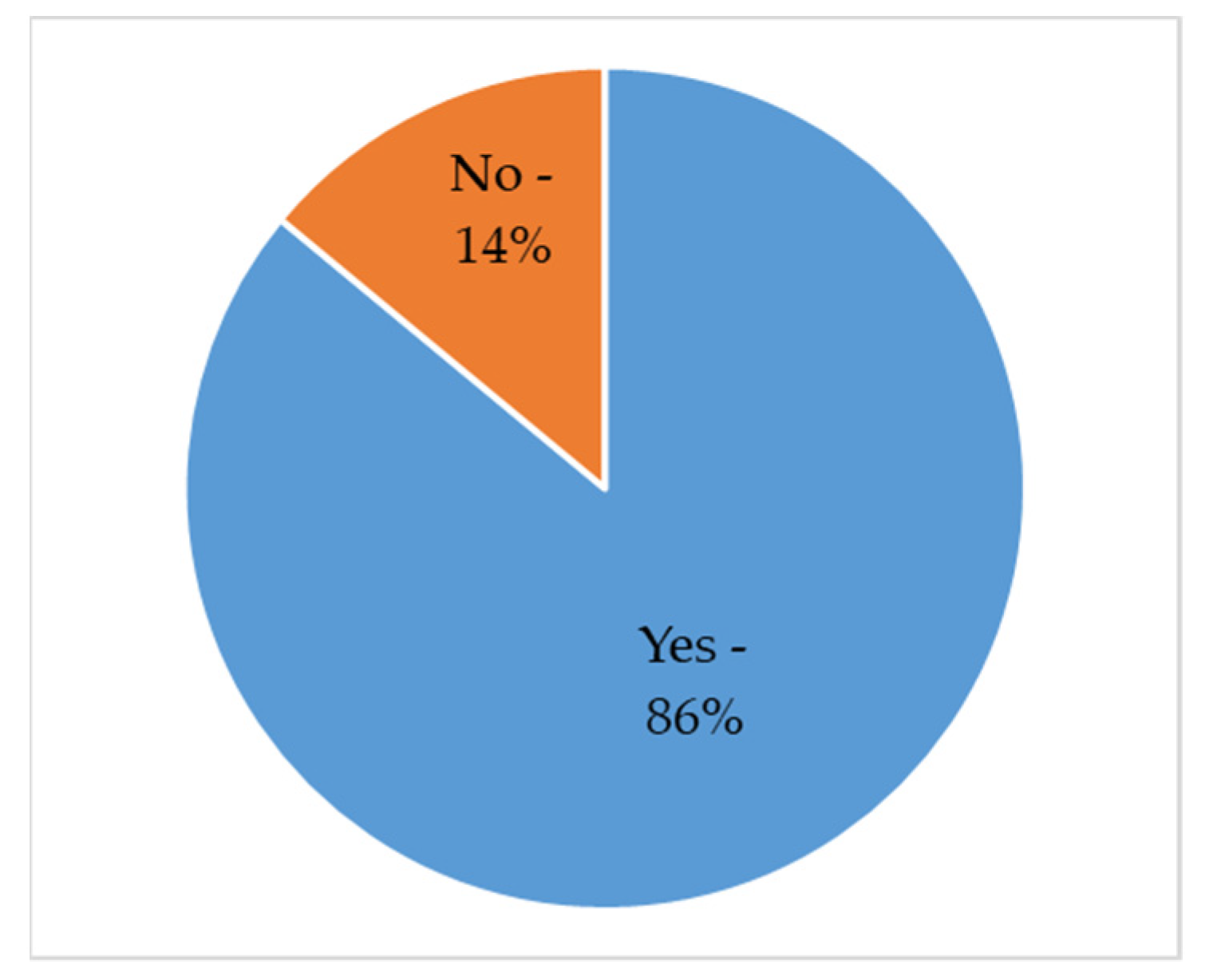
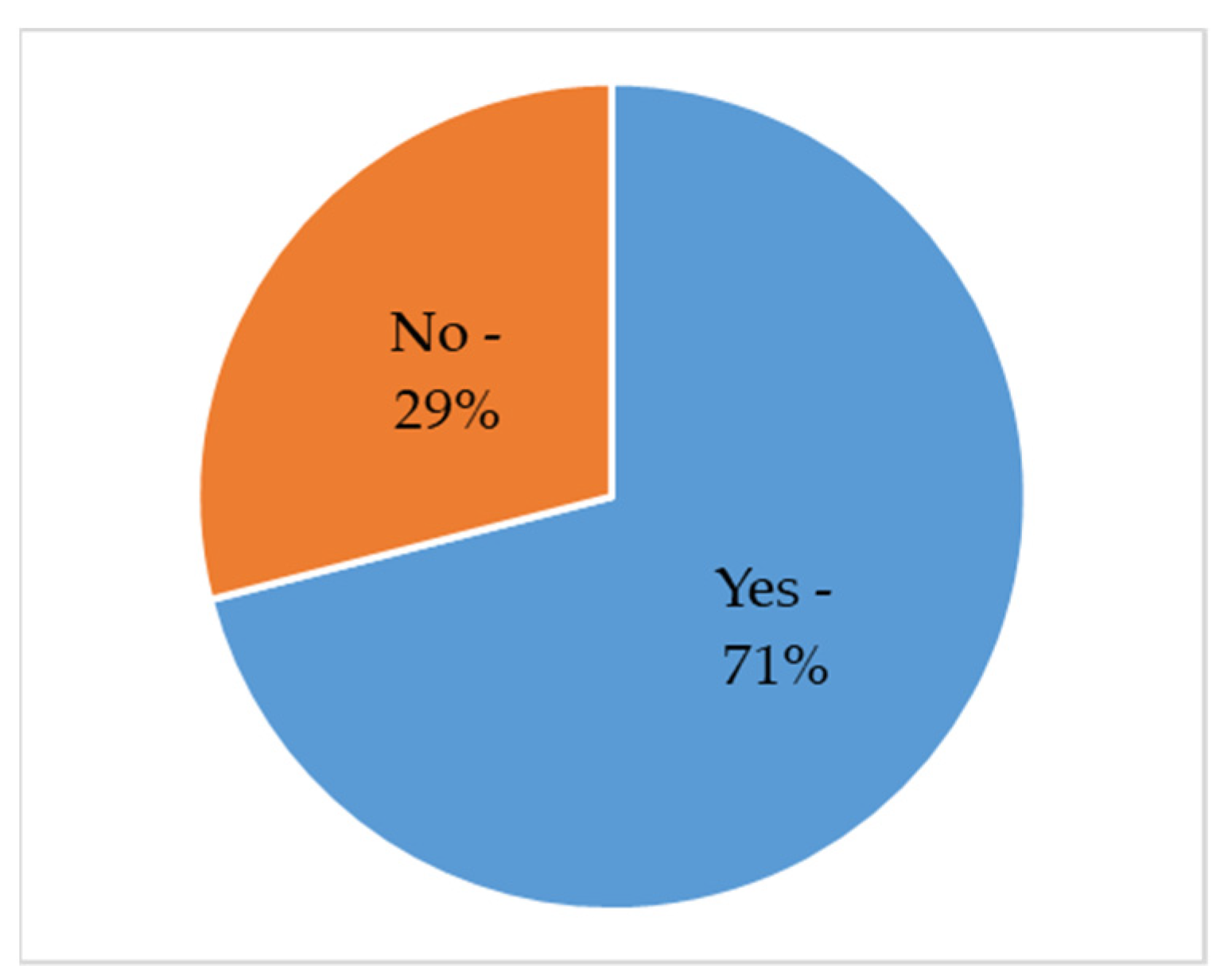
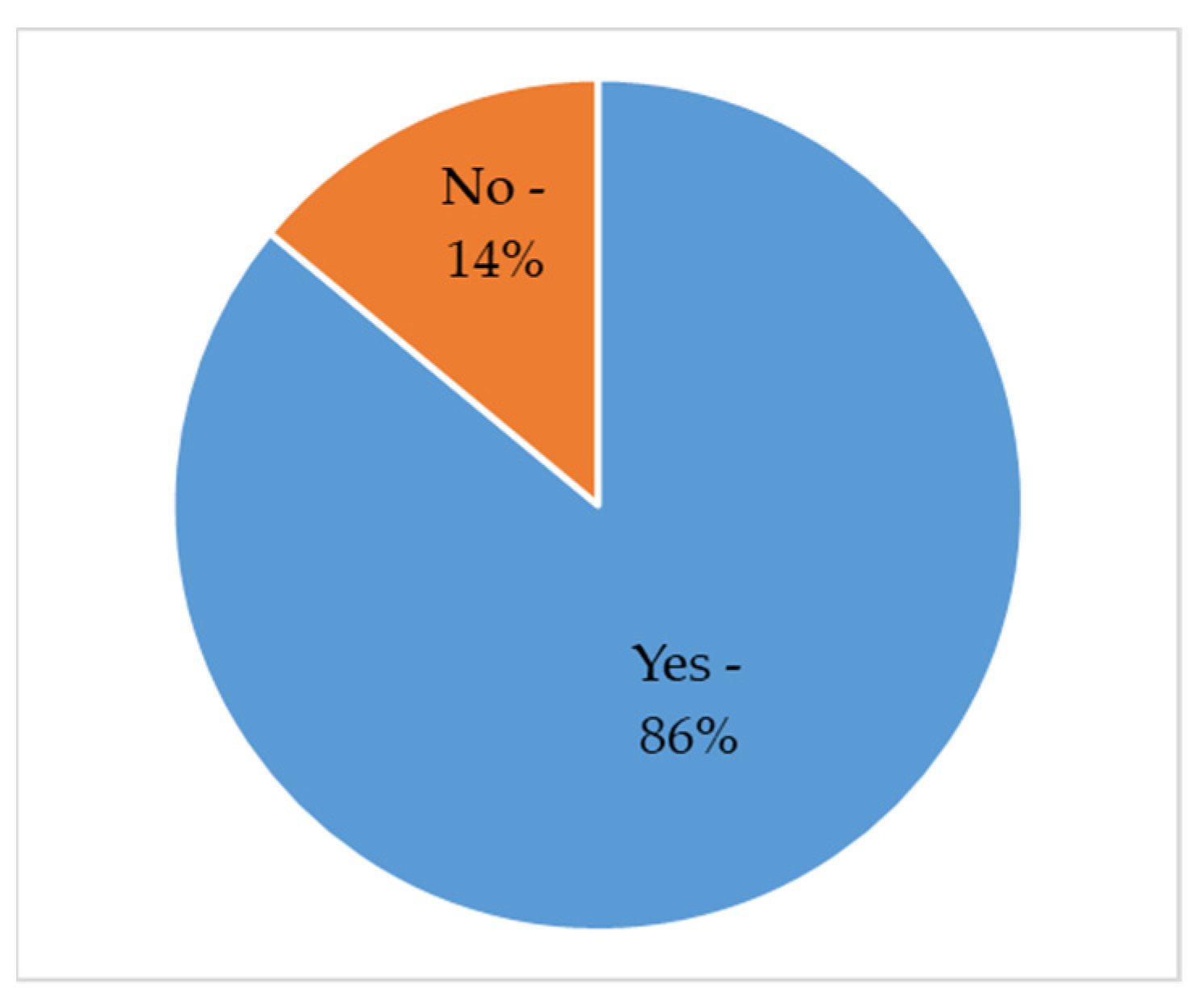

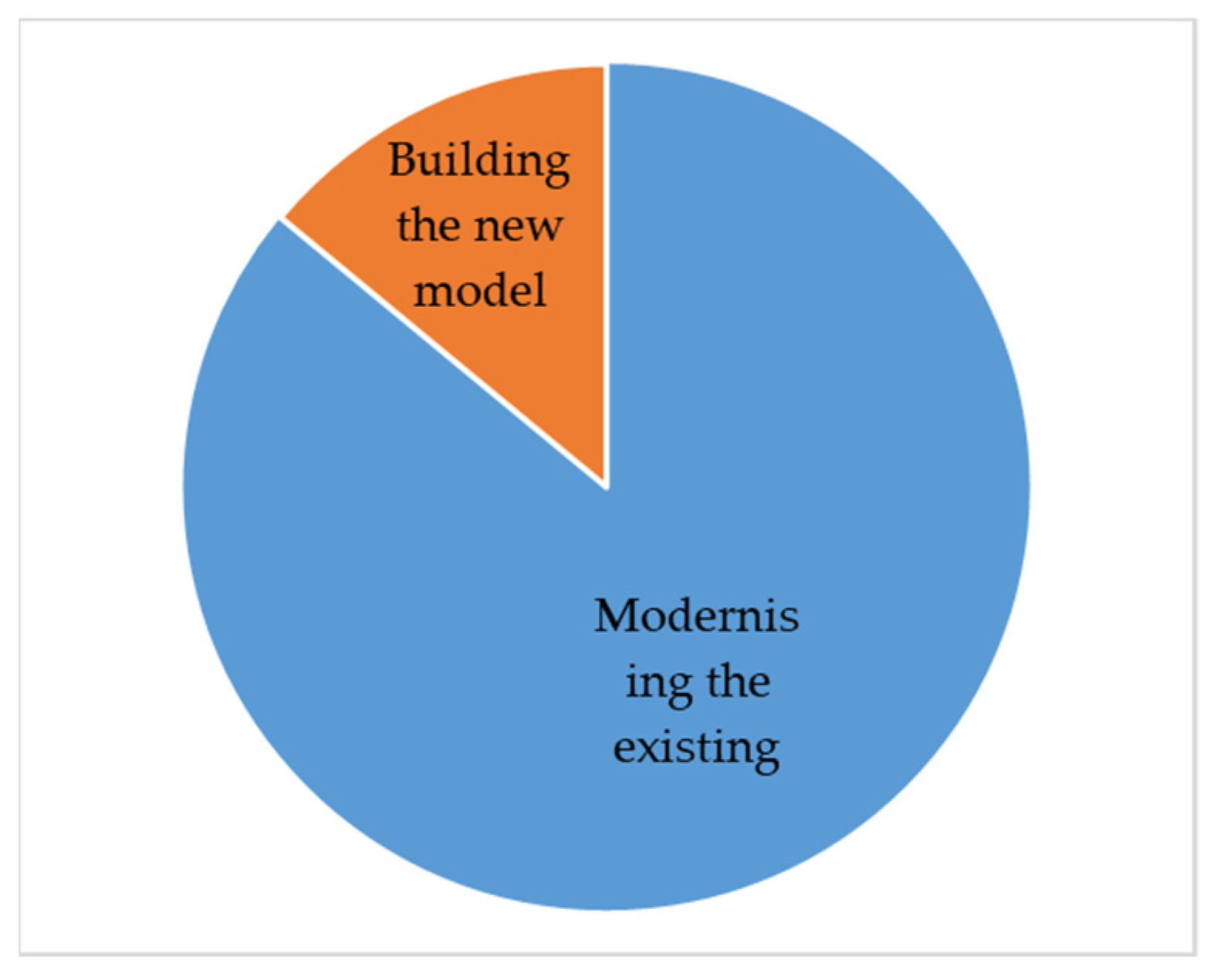
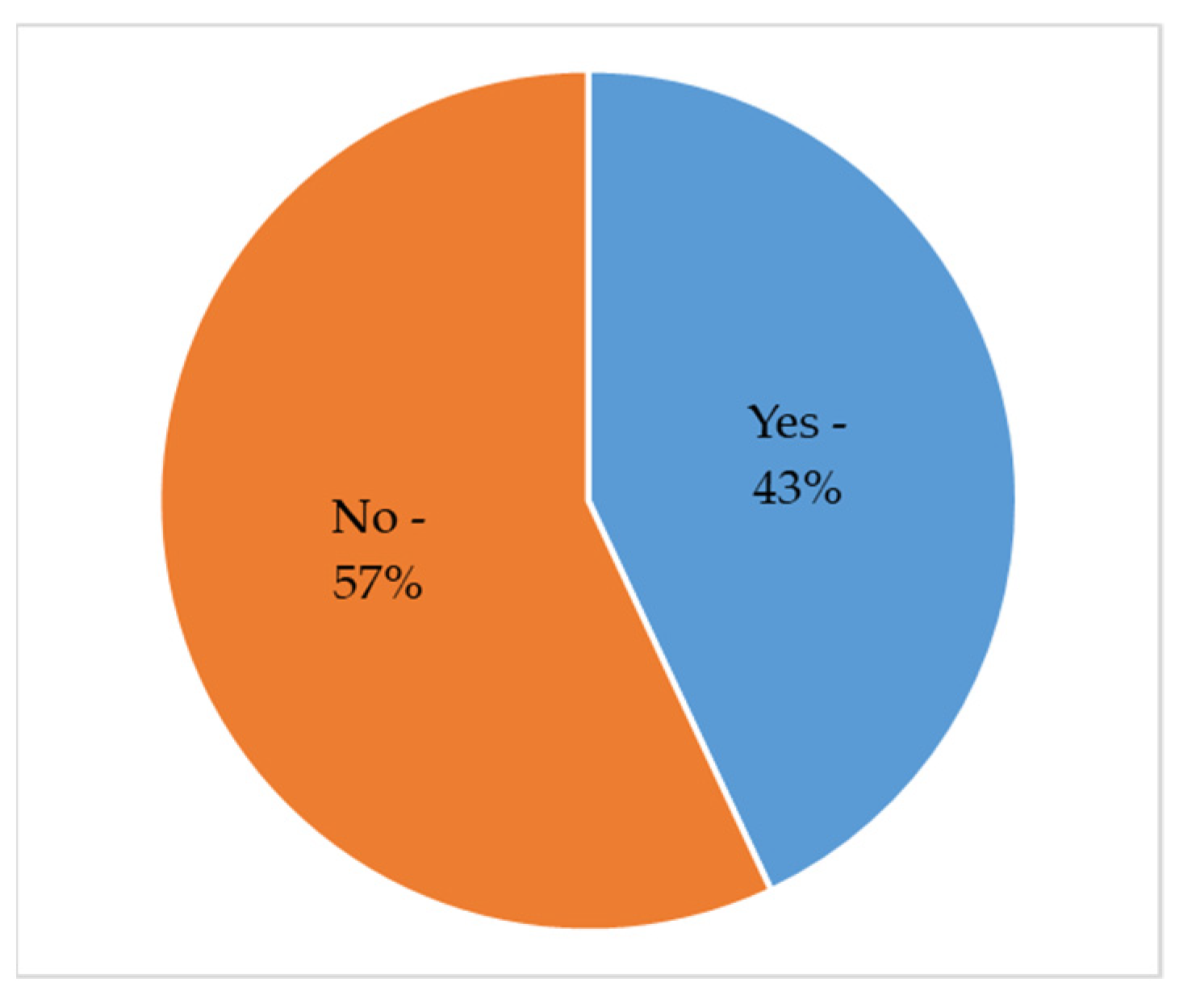
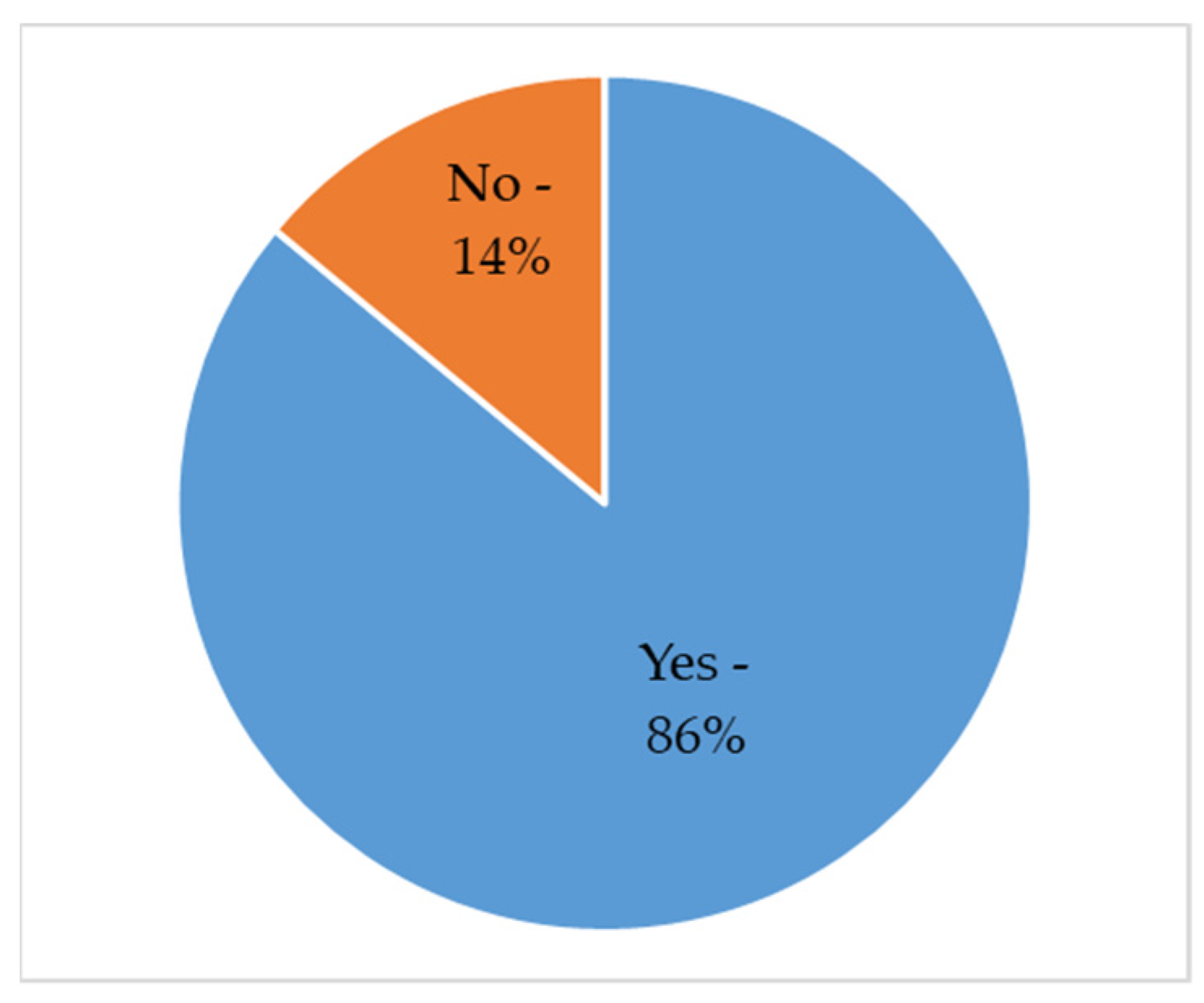
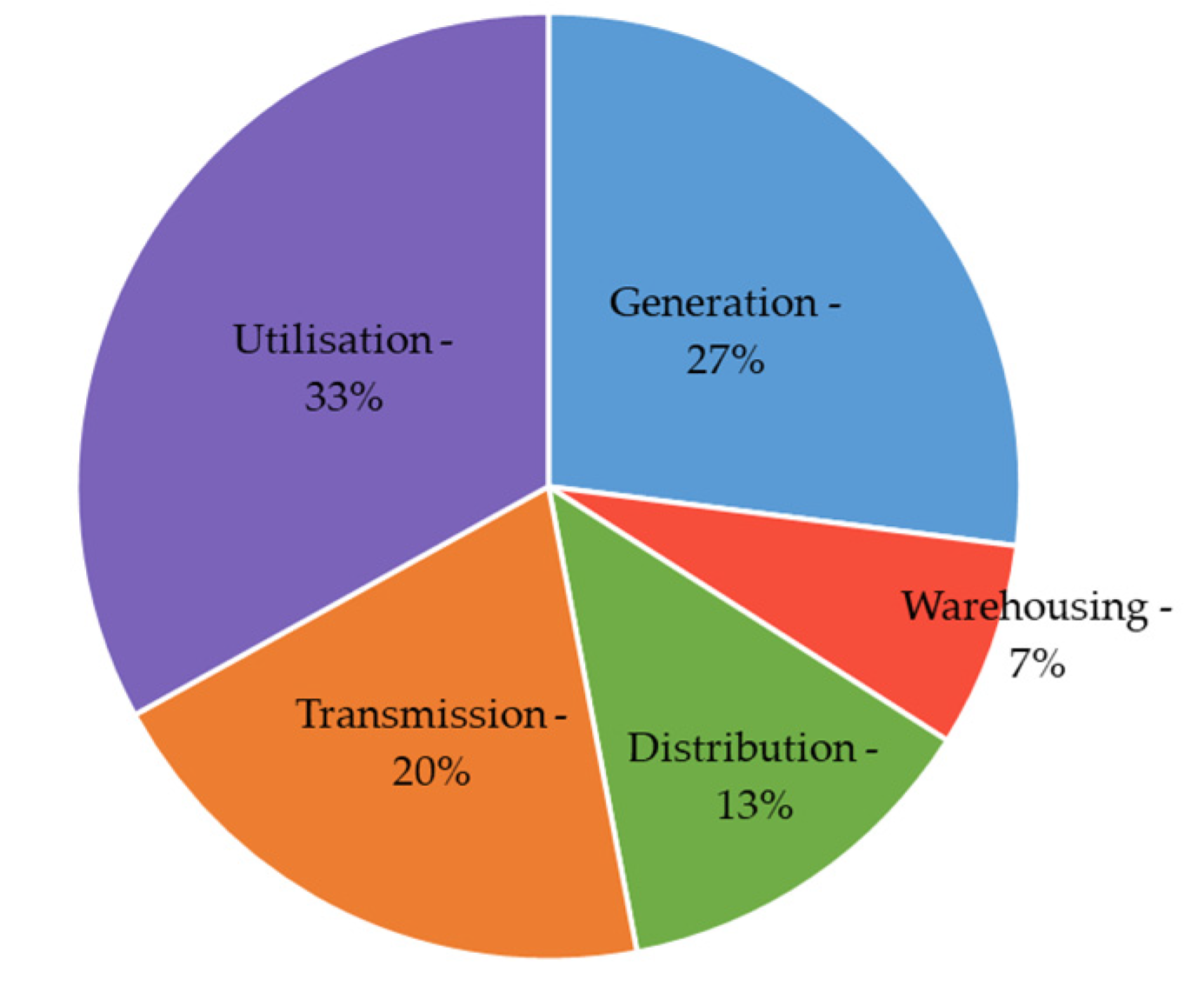
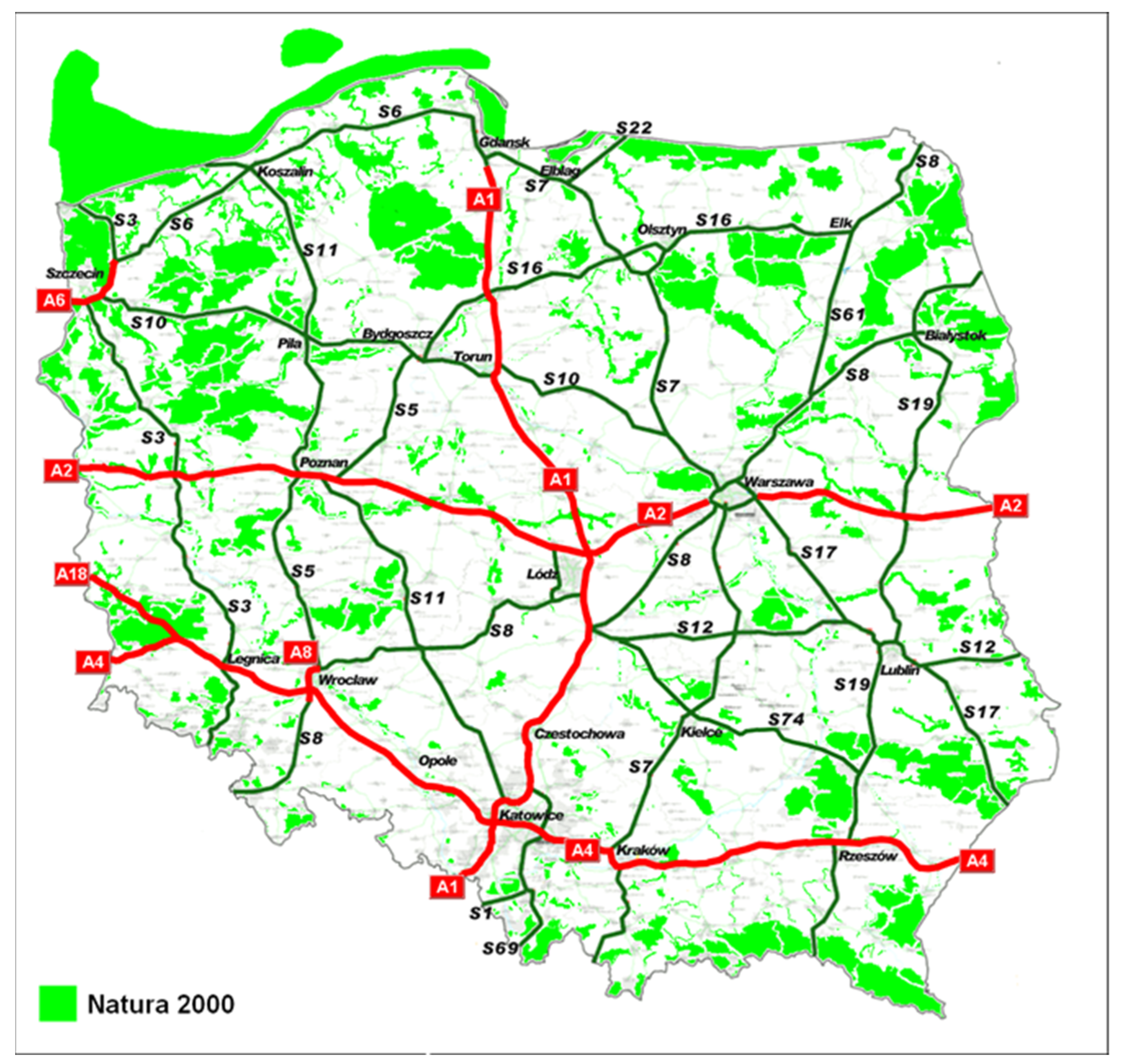
| Energy Source | Location in Energy Portfolio * | |
|---|---|---|
| In 2030 | ||
| Solar energy | S | QM |
| CC | D | |
| Wind energy | S | QM |
| CC | D | |
| Hydropower | S | QM |
| CC | D | |
| Bioenergy | S | QM |
| CC | D | |
| Energy from decarbonised gases | S | QM |
| CC | D | |
| Energy from cogeneration | S | QM |
| CC | D | |
| Energy from hydrogen | S | QM |
| CC | D | |
| Energy from fossil fuels/coal | S | QM |
| CC | D | |
| Energy from fossil fuels/natural gas | S | QM |
| CC | D | |
| Energy from fossil fuels/crude oil | S | QM |
| CC | D | |
| Location | Options | First Choice | Last Choice | |
|---|---|---|---|---|
 | ||||
 | ||||
| Location | Options | First Choice | Last Choice | |
|---|---|---|---|---|
 | ||||
 | ||||
| Location | Options | First Choice | Last Choice | |
|---|---|---|---|---|
 | ||||
 | ||||
| Energy Source | Location in Energy Portfolio * | |
|---|---|---|
| In 2030 | ||
| Solar energy | S | QM |
| CC | D | |
| Wind energy | S | QM |
| CC | D | |
| Hydropower | S | QM |
| CC | D | |
| Bioenergy | S | QM |
| CC | D | |
| Energy from decarbonised gases | S | QM |
| CC | D | |
| Energy from cogeneration | S | QM |
| CC | D | |
| Energy from hydrogen | S | QM |
| CC | D | |
| Energy from fossil fuels/coal | S | QM |
| CC | D | |
| Energy from fossil fuels/natural gas | S | QM |
| CC | D | |
| Energy from fossil fuels/crude oil | S | QM |
| CC | D | |
| Renewable Energy Sources | Trend | Strength of Impact from −3 to +3 | Probability 0–1 |
|---|---|---|---|
| Solar energy developmen | growth | 1.5 | 0.6 |
| stabilisation | −1 | 0.3 | |
| decrease | −2.5 | 0.1 | |
| Development of wind energy | growth | 1 | 0.5 |
| stabilisation | −1 | 0.3 | |
| decrease | −2 | 0.2 | |
| Development of hydrogen energy | growth | −1 | 0.3 |
| stabilisation | −1.5 | 0.4 | |
| decrease | −2 | 0.3 | |
| Development of energy from cogeneration | growth | 1 | 0.4 |
| stabilisation | −1.5 | 0.4 | |
| decrease | −2 | 0.2 | |
| Development of energy from cogeneration | growth | 2 | 0.5 |
| stabilisation | −1 | 0.3 | |
| decrease | −2 | 0.2 | |
| Development of energy from water resources and geothermal energy | growth | −2 | 0.3 |
| stabilisation | −1.5 | 0.4 | |
| decrease | −2 | 0.3 | |
| Development of energy from decarbonised gases | growth | –1.5 | 0.5 |
| stabilisation | –1 | 0.3 | |
| decrease | −2 | 0.2 | |
| Scenarios | Strength of Impact | ||
| optimistic (+) | 1.4 | ||
| pessimistic (–) | −2.1 | ||
| the most probable (+) | 1.5 | ||
| the most probable (–) | −1.4 | ||
| surprising (+) | 0 | ||
| surprising (–) | −1.9 | ||
| Specification for Year 2018 | Poland | EU-28 |
|---|---|---|
| Solid biofuels | 68.1 | 40.3 |
| Solar energy | 0.9 | 6.4 |
| Hydro | 1.9 | 12.9 |
| Wind | 12.2 | 13.9 |
| Biogas | 3.2 | 7.1 |
| Liquid biofuels | 10.0 | 6.9 |
| Geothermal energy | 0.3 | 2.9 |
| Renewable municipal waste | 1.1 | 4.3 |
| Heat pumps | 2.4 | 5.4 |
| Energy Source | Location in Energy Portfolio * | |
|---|---|---|
| In 2030 | ||
| Solar energy | S | QM |
| CC | D | |
| Wind energy | S | QM |
| CC | D | |
| Hydropower | S | QM |
| CC | D | |
| Bioenergy | S | QM |
| CC | D | |
| Energy from decarbonised gases | S | QM |
| CC | D | |
| Energy from cogeneration | S | QM |
| CC | D | |
| Energy from hydrogen | S | QM |
| CC | D | |
| Energy from fossil fuels/coal | S | QM |
| CC | D | |
| Energy from fossil fuels/natural gas | S | QM |
| CC | D | |
| Energy from fossil fuels/crude oil | S | QM |
| CC | D | |
Publisher’s Note: MDPI stays neutral with regard to jurisdictional claims in published maps and institutional affiliations. |
© 2021 by the authors. Licensee MDPI, Basel, Switzerland. This article is an open access article distributed under the terms and conditions of the Creative Commons Attribution (CC BY) license (https://creativecommons.org/licenses/by/4.0/).
Share and Cite
Horzela, I.; Gromadzki, S.; Gryz, J.; Kownacki, T.; Nowakowska-Krystman, A.; Piotrowska-Trybull, M.; Wisniewski, R. Energy Portfolio of the Eastern Poland Macroregion in the European Union. Energies 2021, 14, 8426. https://doi.org/10.3390/en14248426
Horzela I, Gromadzki S, Gryz J, Kownacki T, Nowakowska-Krystman A, Piotrowska-Trybull M, Wisniewski R. Energy Portfolio of the Eastern Poland Macroregion in the European Union. Energies. 2021; 14(24):8426. https://doi.org/10.3390/en14248426
Chicago/Turabian StyleHorzela, Izabela, Sławomir Gromadzki, Jarosław Gryz, Tomasz Kownacki, Aneta Nowakowska-Krystman, Marzena Piotrowska-Trybull, and Radosław Wisniewski. 2021. "Energy Portfolio of the Eastern Poland Macroregion in the European Union" Energies 14, no. 24: 8426. https://doi.org/10.3390/en14248426
APA StyleHorzela, I., Gromadzki, S., Gryz, J., Kownacki, T., Nowakowska-Krystman, A., Piotrowska-Trybull, M., & Wisniewski, R. (2021). Energy Portfolio of the Eastern Poland Macroregion in the European Union. Energies, 14(24), 8426. https://doi.org/10.3390/en14248426





